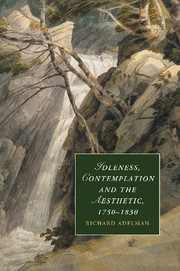Book contents
- Frontmatter
- Contents
- Acknowledgements
- List of abbreviations
- Introduction
- 1 The division of labour
- 2 Utilitarian education and aesthetic education
- 3 Cowper, Coleridge and Wollstonecraft
- 4 Coleridge's Pantisocracy, Biographia and Church and State
- Conclusion
- Epilogue: Wordsworth and Kingsley
- Notes
- Bibliography
- Index
- CAMBRIDGE STUDIES IN ROMANTICISM
Introduction
Published online by Cambridge University Press: 01 June 2011
- Frontmatter
- Contents
- Acknowledgements
- List of abbreviations
- Introduction
- 1 The division of labour
- 2 Utilitarian education and aesthetic education
- 3 Cowper, Coleridge and Wollstonecraft
- 4 Coleridge's Pantisocracy, Biographia and Church and State
- Conclusion
- Epilogue: Wordsworth and Kingsley
- Notes
- Bibliography
- Index
- CAMBRIDGE STUDIES IN ROMANTICISM
Summary
William Wordsworth's poems The Brothers, published in 1800, and ‘Gipsies’, published in 1807, both begin with a denunciation from their different speakers of the apparent idleness of the men and women visible to them. This is the ‘priest of Ennerdale’ in The Brothers censuring the ‘tourists’ (Brothers, 16, 1) he can see from his cottage:
some glance along,
Rapid and gay, as if the earth were air,
And they were butterflies to wheel about
Long as their summer lasted; some, as wise,
Upon the forehead of a jutting crag
Sit perch'd with book and pencil on their knee,
And look and scribble, scribble on and look,
Until a man might travel twelve stout miles,
Or reap an acre of his neighbour's corn.
(Brothers, 2–10)This judgement clearly contrasts vain movement with honest toil. The objects of the priest's attention ‘wheel about’ ‘as if the earth were air’ or sit and ‘scribble’ for the same length of time it would take a man to ‘reap an acre of his neighbour's corn’. Such an opposition between work and leisure is further underlined in the poem's second verse paragraph. There we learn that the priest is not simply surveying the scene before him, but is ‘Employed’ in his ‘winter's work’ (Brothers, 20):
Upon the stone
His Wife sat near him, teasing matted wool,
While, from the twin cards tooth'd with glittering wire,
He fed the spindle of his youngest child,
Who turn'd her large round wheel in the open air
With back and forward steps.
(Brothers, 20–25)- Type
- Chapter
- Information
- Publisher: Cambridge University PressPrint publication year: 2011

